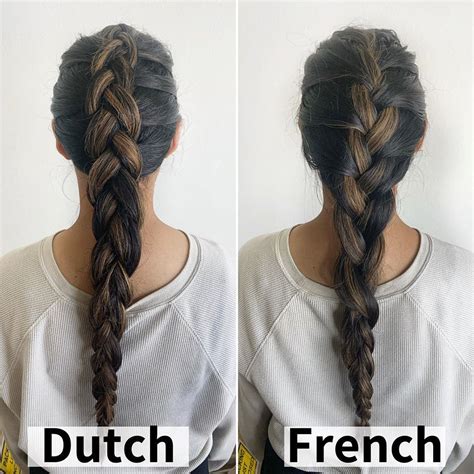Introduction
French and Dutch braids, both intricate and elegant hairstyles, have captivated the hearts of hair enthusiasts for centuries. While sharing similarities, these braids also possess distinct characteristics that set them apart. This article delves into the intricacies of each braid, highlighting their differences and providing a comprehensive guide to their execution.

Definition and Structure
French Braid:
- An inside-out braid where sections of hair are crossed over each other, creating a raised effect.
- Typically starts at the crown of the head and progresses down towards the neckline.
- Known for its delicate and feminine appearance.
Dutch Braid:
- An outside-in braid where sections of hair are crossed under each other, resulting in a raised and voluminous look.
- Often begins at the nape of the neck and works its way up towards the crown.
- Characterized by its sturdy and elaborate appearance.
Key Differences
1. Direction of Crossing
- French Braid: Hair sections are crossed over each other, moving from the outside inwards.
- Dutch Braid: Hair sections are crossed under each other, moving from the inside outwards.
2. Appearance
- French Braid: Raised and delicate, giving a lace-like effect.
- Dutch Braid: Raised and voluminous, creating a more dramatic look.
3. Starting Point
- French Braid: Typically starts at the crown of the head and continues down.
- Dutch Braid: Usually begins at the nape of the neck and moves upwards.
4. Complexity
- French Braid: Generally easier to learn and execute than the Dutch braid.
- Dutch Braid: Requires more coordination and practice to achieve a neat and even braid.
5. Versatility
- French Braid: Versatile and suitable for a wide range of hair types and styles.
- Dutch Braid: More suited for thicker, fuller hair due to its voluminous nature.
6. Hold and Longevity
- French Braid: Tends to hold well and maintain its shape for longer periods.
- Dutch Braid: May loosen more easily due to its voluminous structure.
Benefits and Uses
French Braid:
- Adds a touch of elegance and sophistication to any hairstyle.
- Ideal for formal occasions, weddings, and special events.
- Can help control frizz and flyaways.
Dutch Braid:
- Creates a dramatic and eye-catching statement.
- Perfect for thick, heavy hair that needs to be tamed.
- Versatile, can be worn in a variety of ways, including updos and side braids.
Effective Strategies
For a Perfect French Braid:
- Section off hair at the crown, divide into three equal sections.
- Cross the right section over the middle, then the left section over the new middle.
- Continue this process, adding new hair from the sides as you go.
- Secure the end with a hair tie or ribbon.
For a Flawless Dutch Braid:
- Section off hair at the nape of the neck, divide into three equal sections.
- Cross the right section under the middle, then the left section under the new middle.
- Continue the process, adding new hair from the sides and lifting the previous section under the new braid.
- Secure the end with a hair tie or ribbon.
Why It Matters
- Both French and Dutch braids offer a sophisticated and versatile way to style hair.
- Understanding their differences allows for customization based on hair type and desired look.
- Proficiency in these braiding techniques expands hair styling capabilities and enhances confidence.
Inspiring Innovation
The creative term “Braidology” encompasses the art and science of braiding. By studying the principles of French and Dutch braids, hair professionals and enthusiasts alike can push the boundaries of innovation, creating unique and intricate braid designs.
Comparative Tables
| Feature | French Braid | Dutch Braid |
|---|---|---|
| Direction of Crossing | Inside-out | Outside-in |
| Appearance | Raised, delicate | Raised, voluminous |
| Starting Point | Crown of head | Nape of neck |
| Complexity | Easier to learn | More challenging to execute |
| Versatility | Suitable for various hair types | More suited for thicker hair |
| Purpose | French Braid | Dutch Braid |
|---|---|---|
| Elegance and sophistication | Weddings, special events | Statement-making, dramatic |
| Control frizz and flyaways | Yes | Yes |
| Tame unruly hair | No | Yes |
| Techniques | French Braid | Dutch Braid |
|---|---|---|
| Section hair into three equal parts | Yes | Yes |
| Start at the crown / nape of the neck | Yes | Yes |
| Cross the right section over / under the middle | Yes | Yes |
| Add new hair from the sides | Yes | Yes |
| Secure the end with a hair tie or ribbon | Yes | Yes |
